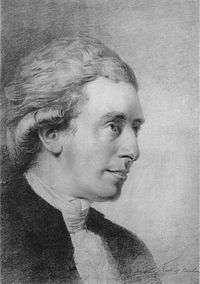David Erskine, 11th Earl of Buchan

David Steuart Erskine, 11th Earl of Buchan (12 June 1742 – 19 April 1829), styled Lord Cardross between 1747 and 1767, was a Scottish antiquarian and patron of the arts and sciences.[1]
Background and education
Erskine was the second but eldest surviving son of Henry Erskine, 10th Earl of Buchan, by Agnes, daughter of Sir James Steuart, 7th Baronet. He was the brother of Henry Erskine and Lord Erskine. He studied at St. Andrews University and Edinburgh University. He married, on Oct. 15, 1771, his cousin Margaret Fraser (d. May 12, 1819), the great-granddaughter of David Erskine, 9th Earl of Buchan.[2] They had no children.
Career
His pertinacity helped in effecting a change in the method of electing Scottish representative peers, and in 1780 he succeeded in founding the Society of Antiquaries of Scotland. His correspondents included Horace Walpole, and he produced an Essay on the Lives of Fletcher of Saltoun and the Poet Thomson (1792) and other writings. He died at his residence at Dryburgh (near Dryburgh Abbey, in the Scottish Borders) in April 1829, leaving no legitimate children, and the earldom passed to his nephew Henry.
He was the Secretary at the British Embassy in Madrid in 1766–67. He was also the Grand Master of Scottish Freemasons from 1782 to 1784.[2]
He conducted a correspondence with George Washington and sent him a box made from the oak that hid William Wallace after the Battle of Falkirk. The box was designed by the Goldsmith Company of Edinburgh, and the earl requested that Washington, upon his death, pass it on to the man in his country whom he believed should merit it best, and upon the same conditions that induced the earl to send it to Washington. In his will Washington thanked the earl for presenting the box to him along with sentiments which accompanied it; feeling incapable of making the choice asked of him he bequeathed the box back to the earl.[3]
Erskine was elected a member of the American Antiquarian Society in 1816.[4] He
He also commissioned a cable-stayed bridge over the River Tweed at Dryburgh. He opened this bridge on 1 August 1817 but it collapsed within months. A replacement was built after a redesign, but this too collapsed in 1838. A more permanent bridge did not arrive until 1872, when the suspension system was used instead.
There is an interesting story concerning the Earl in which the writer George Dyer brought him to meet Charles Lamb at his flat in Mitre Court Buildings. Charles Lamb was not home and his sister Mary Lamb was deeply flustered at having to greet an Earl unannounced in her household.
References
- ↑ Michael Kassler, 'The Earl of Buchan's connections with early English lithography', Journal of the Printing Historical Society n.s. 24 (2016), pp. 5-9.
- 1 2 [Cracroft's Peerage: The Complete Guide to the British Peerage & Baronetage, online (http://www.cracroftspeerage.co.uk/online/content/buchan1469.htm)]
- ↑ Last Will and Testament of George Washington, 9 July 1799
- ↑ American Antiquarian Society Members Directory
External links
| Masonic offices | ||
|---|---|---|
| Preceded by The Earl of Crawford |
Grand Master of the Grand Lodge of Scotland 1782–1784 |
Succeeded by The Earl of Aberdeen |
| Peerage of Scotland | ||
| Preceded by Henry Erskine |
Earl of Buchan | Succeeded by Henry Erskine |